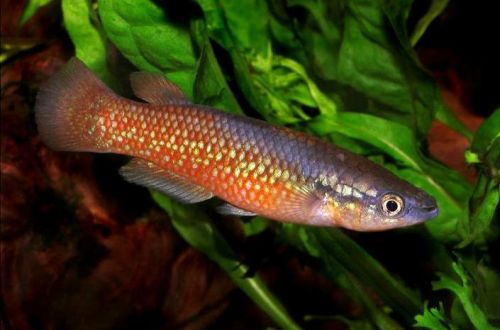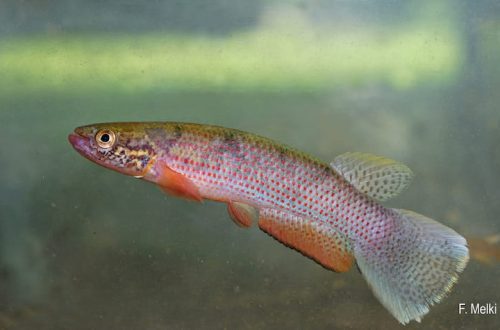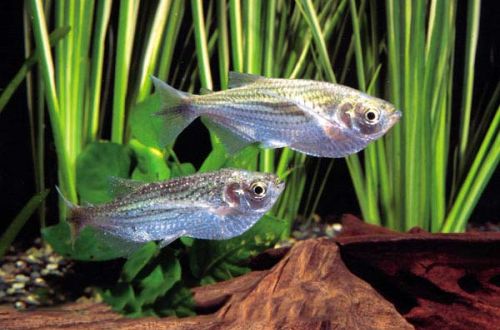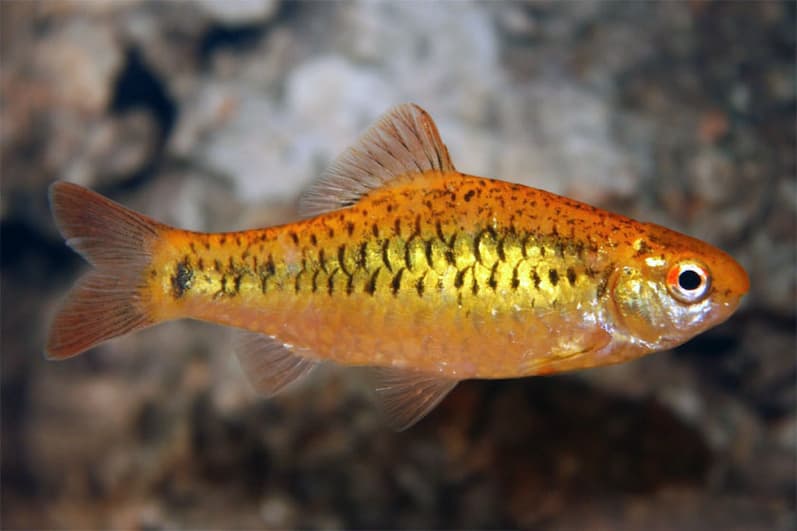
Golden Barbus
The Golden Barb, scientific name Barbodes semifasciolatus, belongs to the Cyprinidae family. One of the most popular freshwater aquarium fish. The golden color is an artificially bred mutation that appeared due to targeted selection in the 60s. 20th century.

The original color of wild fish is silver with a greenish tinge. In aquariums, these fish with their natural color are very rare.
Contents
Habitat
Wild populations are common in Vietnam, southern China, northern Laos, as well as in the Far Eastern regions of Russia. It lives in small rivers and stagnant bodies of water such as swamps, backwaters of rivers, as well as ditches and irrigation canals. Prefers to stay at shallow depths in coastal areas with dense aquatic vegetation.
Brief information:
- The volume of the aquarium – from 100 liters.
- Temperature – 16-24°C
- Value pH — 6.0–8.0
- Water hardness – soft to hard (2-21GH)
- Substrate type – sandy
- Lighting – subdued
- Brackish water – no
- Water movement – weak current or still water
- The size of the fish is up to 7 cm.
- Nutrition – any food with herbal supplements
- Temperament – peaceful active fish
- Keeping in a flock of 8-10 individuals
Description
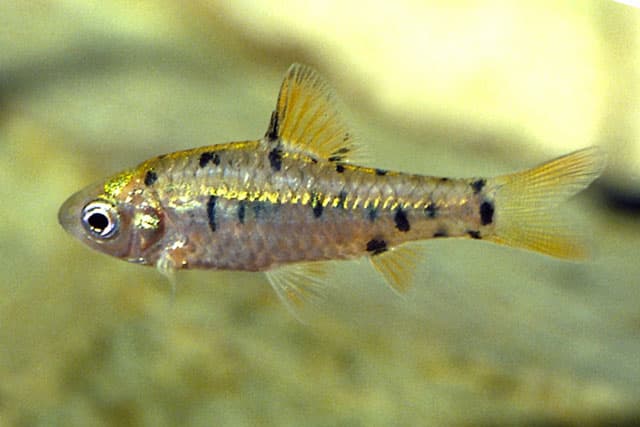
Adult individuals reach about 7 cm. Sexual dimorphism is weakly expressed, males and females are practically indistinguishable from each other outwardly. As noted above, the color of wild individuals is silvery with a greenish tint, a reddish tint is possible on the abdomen. The breeding form has a rich orange-yellow color with dark edging on some scales.
Food
The Golden Barbus is unpretentious, accepts all types of dry, frozen and live food. The main condition is the inclusion of herbal supplements in the daily diet. Feed 2-3 times a day in the amount eaten in 5 minutes, food debris should be removed in a timely manner to prevent unnecessary water pollution.
Maintenance and care, arrangement of the aquarium
The “golden” form of the Barbus is considered one of the most hardy and undemanding species in the modern aquarist. The recommended volume of the tank for a flock of 8-10 fish starts from 100 liters. Any decoration, but the most successful option is a combination of a dark substrate and a certain number of floating plants covering half the surface of the water. Under such conditions and a balanced diet, the fish show their best colors.
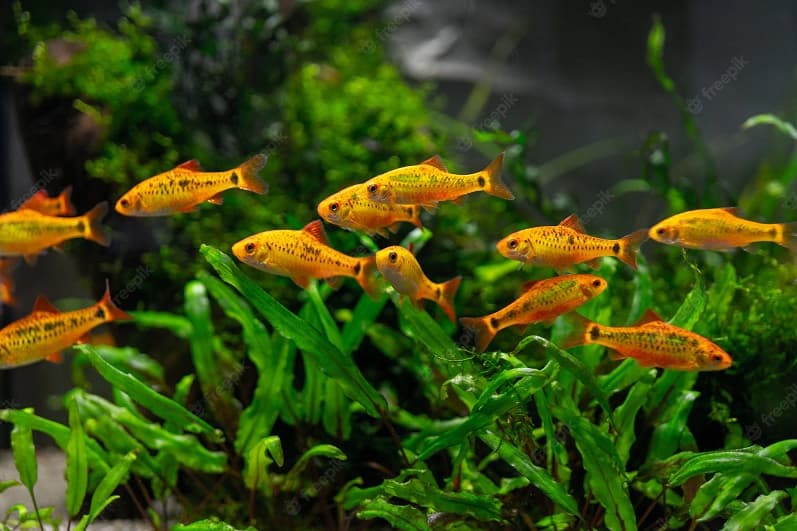
The standard set of equipment consists of filtration and lighting systems. In most cases, a heater is not required for this species if the aquarium is installed in a living area.
Water conditions are characterized by a weak internal flow, temperature, pH and GH parameters are in a wide acceptable range of values, so the water treatment process is minimized, it is enough to let it stand for a day and can be poured into the aquarium.
Aquarium maintenance consists in weekly replacement of part of the water (20–25% of the volume) with fresh water, regular cleaning of the substrate from organic waste and removal of plaque from the glass.
Behavior and Compatibility
Peaceful active fish gets along well with other species of similar size and temperament. The content is gregarious. In a group of 8–10 individuals of both sexes, an internal hierarchy is formed, males are forced to compete with each other for the attention of females, which contributes to an increase in the brightness of their color.
Breeding and reproduction
Golden Barbus belongs to spawning species, females scatter eggs in the water column, and males at this moment fertilize it. Parental instincts are poorly developed, immediately after spawning, the fish can eat their own caviar and fry that have appeared.
Breeding is recommended to be carried out in a separate tank – a spawning aquarium, in order to protect offspring from adult fish. The design is simple, the main attention is paid to the ground, it should consist of particles of a sufficiently large size that do not fit tightly to each other, forming voids, for example, pebbles or decorative glass beads. When the eggs sink to the bottom, most of them fall into these voids and thus become inaccessible to fish. A similar effect is also achieved when using a fine mesh, which is fixed at the bottom.
Another way to ensure the preservation of the eggs is to use low-growing small-leaved plants or mosses such as Riccia floating and Java moss, which are planted on most of the surface of the substrate (in this case, the soil can be any). Dense thickets of plants can provide reliable shelter for eggs no worse than special soil.
The size of the spawning aquarium is usually 20-30 liters, half filled. Of the equipment, a heater and a simple airlift filter are used to prevent accidental suction of eggs and fry. Spawning occurs in dim light, so at first there is no need for a light source.
The impetus for the beginning of the mating season is the establishment of water temperature in the region of the upper permissible mark of 23-24 ° C at a neutral or slightly acidic pH value, as well as the inclusion of protein foods in the daily diet – bloodworms, daphnia, brine shrimp in live or frozen form.
After some time, the females become noticeably rounder, and the males begin to actively show signs of attention to their chosen ones. At this point, you should prepare a separate tank and fill it with water from the general aquarium, then transplant several females and the most colorful males there. The easiest way to determine the end of spawning is by females, they will become more slender.
The fish are returned. The fry will appear in 24-48 hours, and in a day they will begin to swim freely. Feed with specialized microscopic food for feeding juvenile aquarium fish or brine shrimp nauplii.
Fish diseases
A balanced diet and suitable living conditions are the best guarantee against the occurrence of diseases in freshwater fish, so if the first symptoms of an illness appear (discoloration, behavior), the first thing to do is check the condition and quality of the water, if necessary, return all values to normal, and only then do treatment. Read more about symptoms and treatments in the Aquarium Fish Diseases section.
Source: FishBase



